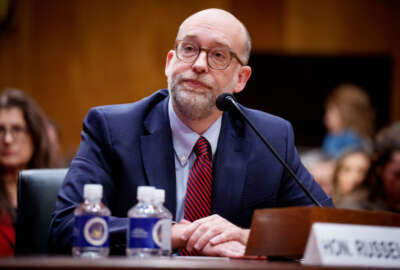OPM delivers final rule on paid administrative leave, 8 years after law was passed
OPM said the years of delay on the administrative leave final rule came after “certain issues” arose in public comments on the proposed regulations in 2017.
After eight years in limbo, agencies should now no longer be able to place federal employees on administrative leave indefinitely during personnel investigations.
The Office of Personnel Management published a final rule this week on the 2016 Administrative Leave Act, capping how long federal employees can remain on administrative investigative leave to 10 days per year. The regulations clarify how agencies should implement the restrictions on paid administrative leave for employees who are under investigation or awaiting a decision on an adverse personnel action.
Congress passed the legislation as part of the fiscal 2017 National Defense Authorization Act after growing concerns about the costs associated with administrative leave, as well as the long time periods agencies were taking to complete personnel investigations. In 2014, the Government Accountability Office estimated that the salaries of federal employees on paid administrative leave were costing the government $31 million per year.
Congress initially gave OPM until September 2017 — about nine months — to implement guidance for agencies. But it ultimately took eight years for OPM to finalize the regulations on administrative leave.
The final rule also comes several months after the Public Employees for Environmental Responsibility filed a lawsuit against OPM to try to get the agency to finalize the long-awaited guidance on the Administrative Leave Act.
“We like to think that our activism and advocacy and formal petition and legal process pushed them to get it done — and it really needed to get done,” PEER Senior Counsel Peter Jenkins said in an interview.
OPM said the yearslong delay on the final rule was due to “certain issues” arose in public comments on the proposed regulations in 2017. For instance, some of the comments from federal unions requested clarification on if OPM’s guidance would interfere with bargaining rights or legal obligations in collective bargaining agreements.
In the final regulations, OPM clarified that an existing collective bargaining agreement would take precedent over the administrative leave regulations, if they came before the final rule is put in place. But any future collective bargaining agreements have to comply with the requirements in the new final rule.
Still, the concerns that were raised in the public comments “led to additional consideration and deliberation, resulting in fresh and more recent analysis of the law, its legislative history, the proposed regulations and the comments received on the proposed regulations,” OPM said. “OPM is now pleased to be in a position to release final regulations that support effective leave administration and government operational transparency.”
The Administrative Leave Act codified three categories of paid leave in Title 5: investigative leave, notice leave and weather and safety leave. OPM first proposed regulations on the legislation in 2017, but then left the regulations for investigative leave and notice leave unfinalized for years. OPM did, however, finalize regulations on weather and safety leave in 2018. OPM said the new final rule should ensure consistency in how agencies use and track administrative leave.
“Although OPM has previously provided guidance on the proper use of administrative leave, agencies will now have the benefit of codified parameters for these new leave categories,” OPM said. “These provisions will also help agencies, OPM, Congress and other stakeholders monitor whether supervisors use these types of leave appropriately and sparingly.”
During the eight years that the regulations were still pending finalization, agencies were able to continue keeping some federal employees who were under investigation on paid administrative leave indefinitely. The costs of the paid leave vary greatly by agency, but in the final rule, OPM estimated that the governmentwide costs amount to about $37.8 million each year.
Jenkins said many of PEER’s clients hade been placed on administrative investigative leave, with no guardrails on the length of the leave. In many cases, employees were put on leave for months — and in several cases, for years. The practice has taken place during several different presidential administrations, but Jenkins said he was particularly concerned about it becoming more common in the next Trump administration.
“It appeared that whistleblowers were put on administrative investigative leave because it was convenient to sideline them,” Jenkins said. “It’s not unique to the Trump administration, but we’re very worried that that will get much worse with whistleblowers under [Trump’s second term], based on the signals that they’re already sending about how they’re going to treat the civil service.”
Now that OPM has issued final regulations, PEER’s lawsuit will be dismissed.
“That was the goal — not just to get them to issue regulations, but to achieve much better safeguards on the use of administrative investigative leave for all federal civil servants going forward,” Jenkins said. “The abuse of administrative investigative leave would have been really scary, and we’re hopeful that this rule is actually going to prevent them from doing that.”
With the final rule in place for investigative and notice leave, agencies’ use of administrative leave should be much more tightly regulated. According to the regulations, paid administrative leave should be capped to 10 days per year. In some investigation cases, the leave can be incrementally extended up to 90 days, but agencies still have to consider alternatives before issuing an extension.
Additionally, the final rule clarifies that a manager keeping an employee on investigative leave improperly for more than 70 days would be considered a prohibited personnel practice, and that manager would be subject to disciplinary action.
The long absence of the final rule, and the practice of keeping feds on leave indefinitely, has negatively impacted federal employees’ careers, promotional opportunities and general wellbeing, according to Jason Briefel, a partner at Shaw Bransford & Roth. Despite the lengthy timeline for reaching the final rule, Briefel said he was “thrilled” to see the OPM regulations finally in place.
“The reality is that in the absence of this rulemaking from OPM in the past eight years, that practice has continued,” Briefel said in an interview. “OPM’s inaction has allowed this abuse by agencies and this waste of taxpayer resources to continue for almost a decade … I’m glad that this has finally been dealt with, and I look forward to seeing it get implemented. But I do think that Congress and the inspector general should look into this — how did this happen?”
“I think agencies are going to have to get their act together and implement this law quickly,” Briefel added.
OPM’s final regulations on the Administrative Leave Act will officially take effect on Jan. 16, 2025.
Copyright © 2025 Federal News Network. All rights reserved. This website is not intended for users located within the European Economic Area.
Drew Friedman is a workforce, pay and benefits reporter for Federal News Network.
Follow @dfriedmanWFED






